Table of Contents
Table of Contents
- 1. The Most Common Team Management Challenge Is Tracking Billable Time
- 2. Top Agencies Win a Significant Percentage of Their Sales Pitches
- 3. Team Expansion Is on the Horizon for More Than Half of Agencies
- 4. On Average, Agencies Retain Clients for 2 to 5 Years
- 5. Project Management and Client Reporting Are the Keys to Agency Success
- 6. Monthly Reporting Is the Preferred Frequency for a Second Consecutive Year
- 7. Most Agencies Do Not Charge Separately for Client Reports
- 8. Most Clients Are Diligent About Reviewing Their Reports
- 9. Clients and Agencies Alike Value Data Visualization
- 10. Agencies Focus on High-Level Summaries and Key Data Sources
- 11. Clients Prioritize 1 to 5 KPIs, With Conversions Leading the Way
- 12. Agencies Utilize Real-Time Internal Dashboards for Campaign Tracking
- Invest in the Right Management Systems To Grow Your Agency
7,000+ agencies have ditched manual reports. You can too.
Free 14-Day TrialQUICK SUMMARY:
AgencyAnalytics surveyed 251 agencies to gather feedback on internal processes, reporting procedures, and client preferences. This article provides a detailed look at agency management trends, along with everyday challenges and actionable tips. It also explores historical trends based on benchmark reports from previous years.
In part one of our 2024 AgencyAnalytics Marketing Agency Benchmarks Survey, we explored the top trends affecting the industry. To complement these findings, in part two, we will delve into internal agency management trends, including popular reporting habits, operational pain points, and projections for the year ahead.
If you’ve ever wondered how your pitch win rate stacks up to the competition or how long other agencies retain their clients, you’re in the right place. These findings from 251 marketing agencies–just like yours–will provide a baseline for industry averages in 2024.
And now, with the release of our 2025 Marketing Agency Benchmarks report, you’ll also have the most up-to-date insights to help guide your agency’s strategy for the coming year.
1. The Most Common Team Management Challenge Is Tracking Billable Time
Close to half of agencies agree: Allocating billable time is a sore spot.
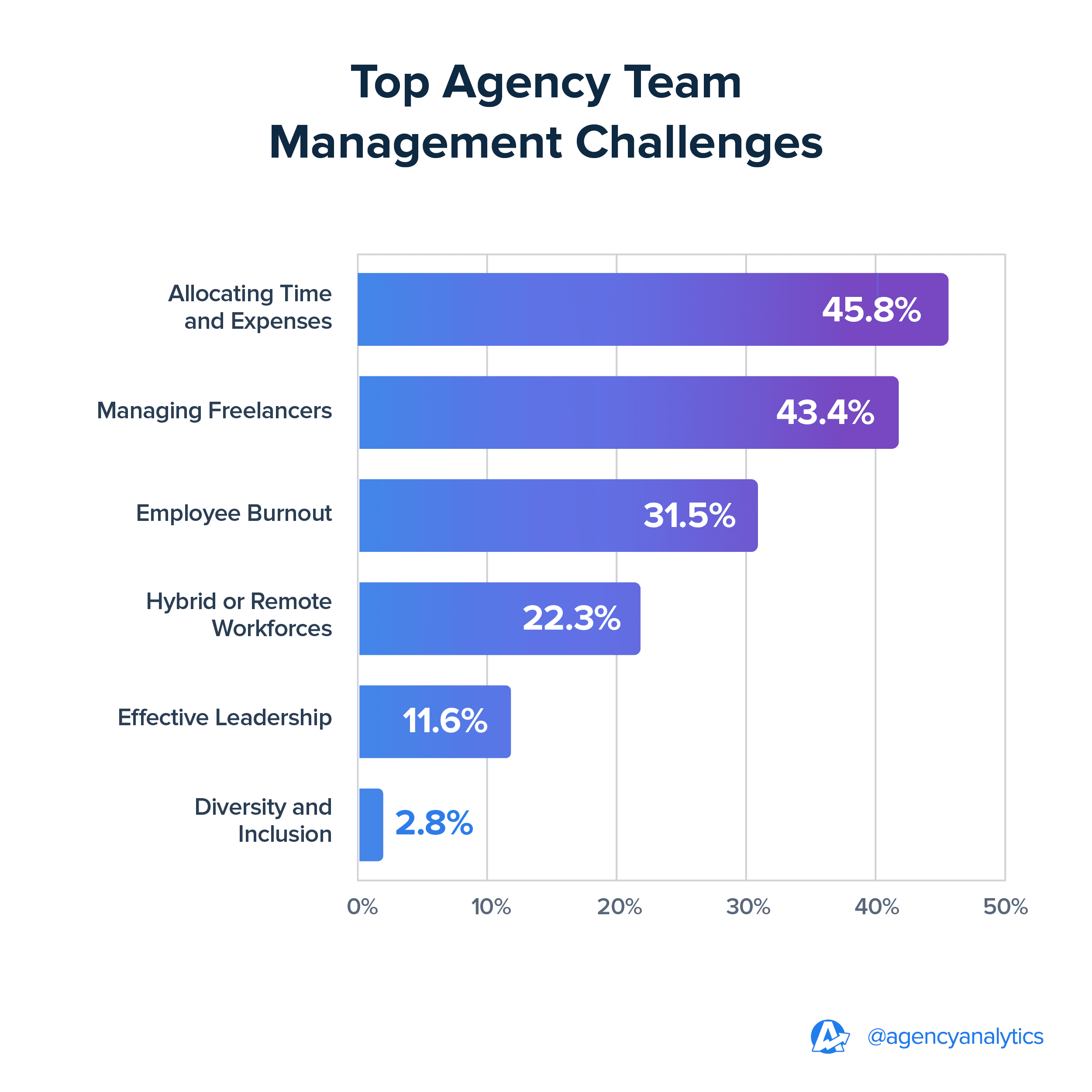
When a client calls, or you’re squeezing in an extra round of revisions, monitoring the clock may not be your first instinct. After all, there’s work to be done. However, not having a system to track billable hours could cost you (literally).
While you can’t realistically track everything to a T, here are a few actionable tips:
Implement Time-Tracking Software: Time-tracking tools come in handy to log billable time. For example, consider a website design project. A time-tracking tool could be used to log hours spent on various phases (e.g., wireframing, design, content creation, and client meetings).
Establish Detailed Time Tracking Policies: Define clear guidelines on what constitutes billable vs. non-billable time (e.g., consider client meetings, one-off phone calls, or design changes).
Add Buffer Time for Revisions: Build in extra time for potential revisions when planning projects. Also, set a cap in your agency-client contracts to ensure everyone is on the same page.
Conduct Weekly Reviews: As a best practice, set some time aside each week to monitor the billable time assigned per project. This helps catch and correct errors promptly.
2. Top Agencies Win a Significant Percentage of Their Sales Pitches
Our data has shown that most agencies won 31% to 50% of their sales pitches in the past year.
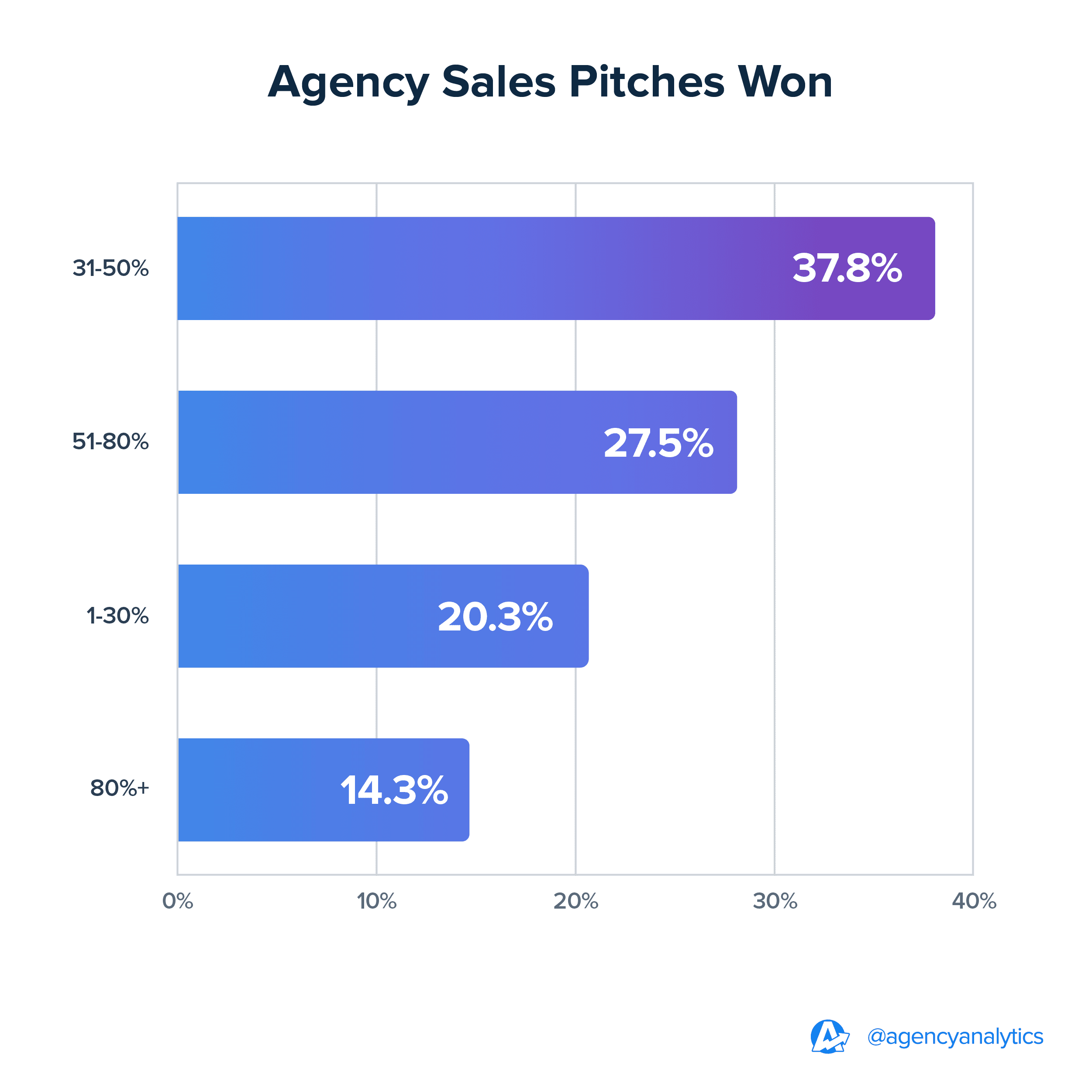
What’s even more promising is that nearly 42% of agencies won more than half of their sales pitches (i.e., adding the 28% and 14% stats from above).
A reasonable conclusion is that these agencies have perfected this art over time. Perhaps they frequently run mock sales pitch presentations. On the other hand, they may have invested in a professionally-designed document that’s easy to customize and replicate.
We tend to have a default outline we use and update for each client. For specific cases or industries, we tailor the sales pitch deck around that specific client, industry, or sector.
Ryan Stack, Co-Founder, The Stack Grp
However, a sales pitch presentation is just one part of the puzzle.
To truly win clients over, it’s about understanding their needs early on. In fact, 56% of agency leaders credit this approach with converting prospects into customers.
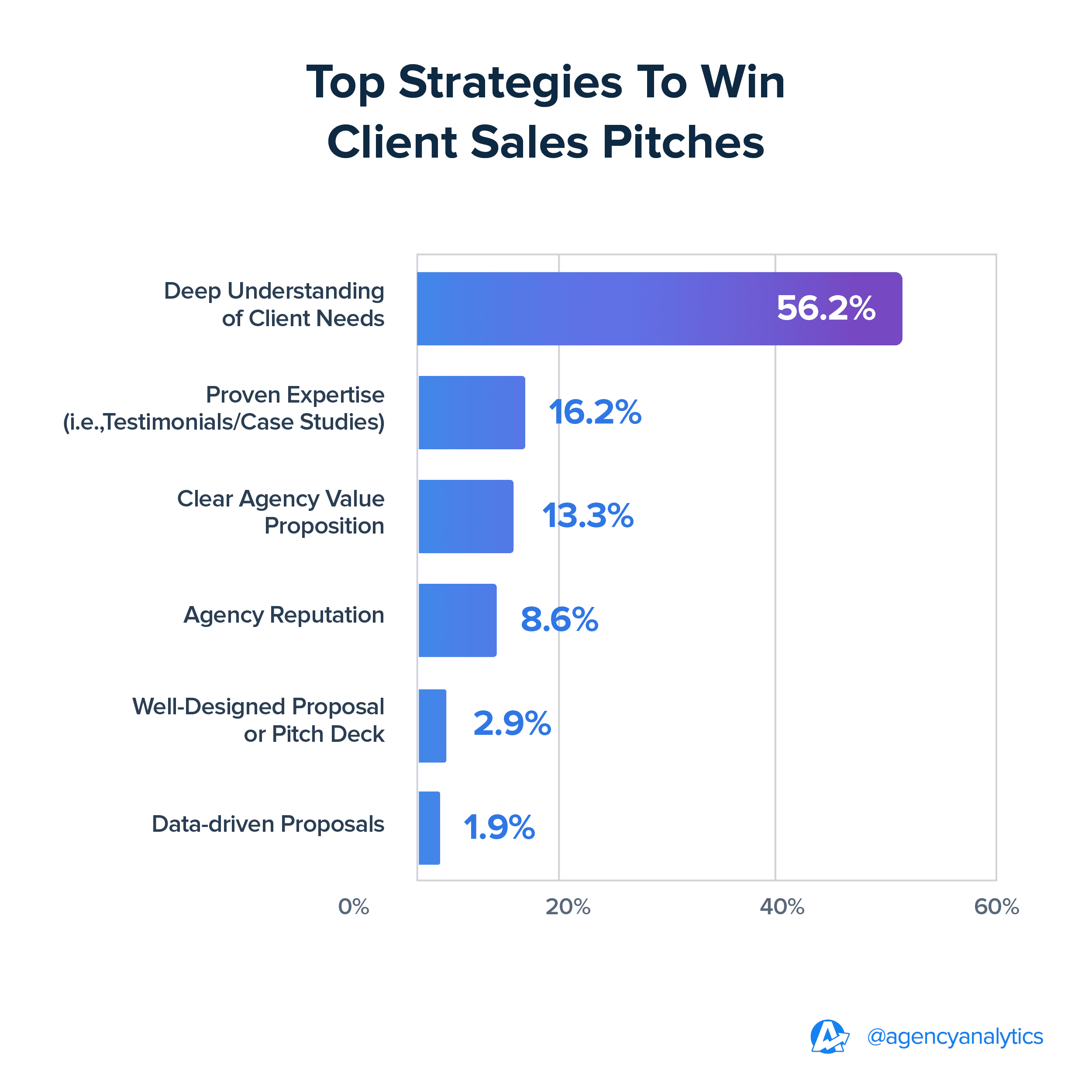
Before we produce any of our pitch decks, we jump on a call and run through a set of qualifying questions we have crafted and tweaked over time. These questions are more about checking that we know everything we should about the prospect. Our golden question, which has often given us our core direction of the pitch, is “What has triggered your decision to speak to us?”. This gets right to the heart of their pain and often tells us where to look next.
Kate Thompson, Digital Strategist, Squidgy
3. Team Expansion Is on the Horizon for More Than Half of Agencies
To meet growing demands, 57% of agency leaders foresee team expansion in the upcoming year.
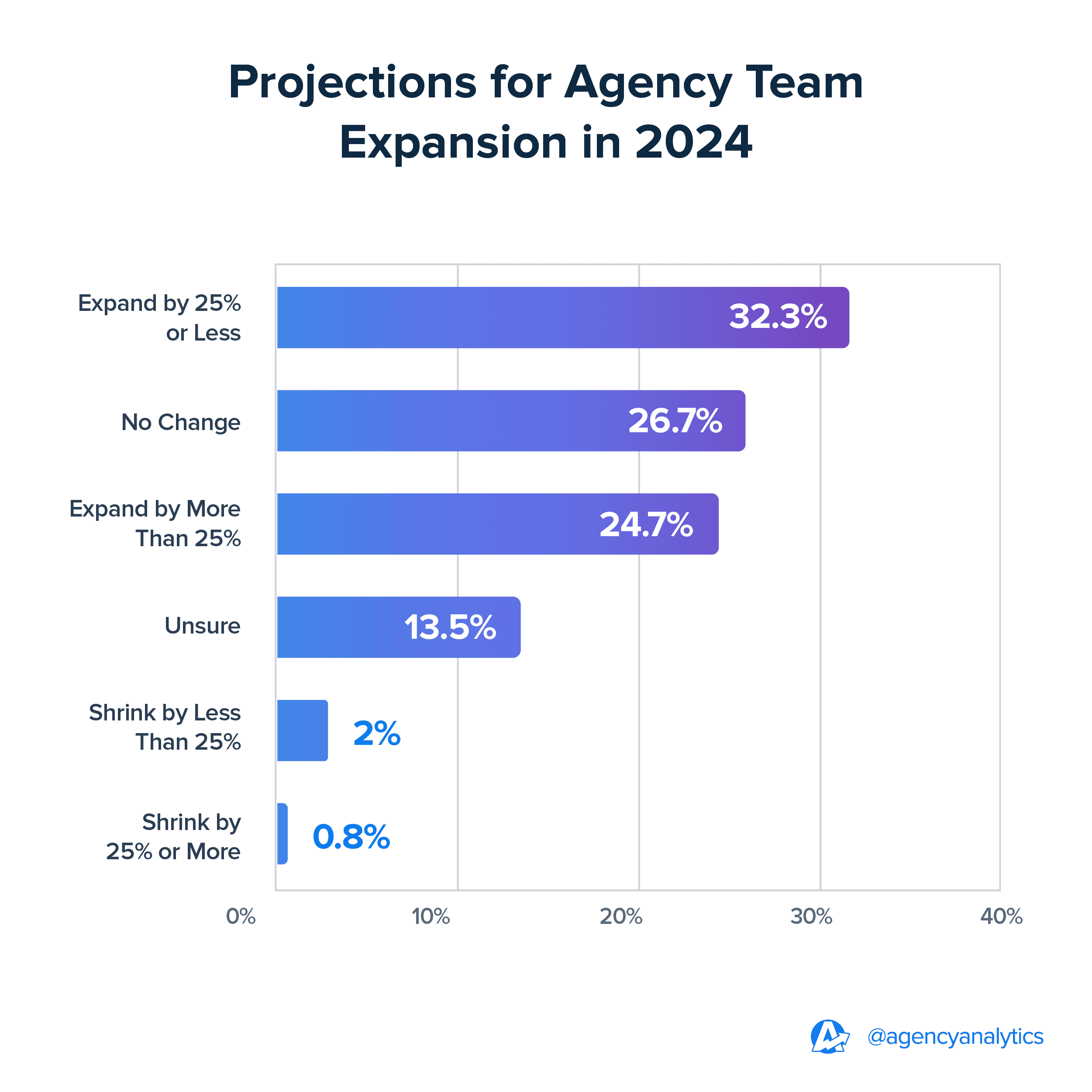
Going back to our previous point, agency growth requires investment.
That also involves finding the right team members. It’s a way to manage an increasing volume of work and ensure no disruptions in service.
For us, it was important to have the right mix of people and then support their individual needs–all while staying focused on the company as a whole. When you're building a company, you don't want to hire all the same types of people. Just like in a recipe, you need different ingredients to make a dish shine.
Yanira M. Castro, CEO, Humanity Communications Collective
To break it down further, here are a few tips for expanding your team.
Tip | Description |
|---|---|
Define Clear Objectives | Establish specific goals for expansion, such as increasing client accounts, enhancing service offerings, or entering new markets. |
Assess Current Team Skills | Identify skill gaps within your current team (e.g., content creation or PPC management). |
Create a Hiring Plan | Develop a detailed plan outlining the roles needed (e.g., content writers, SEO specialists) and timelines for new hires. |
Promote Internal Growth | Provide opportunities for current employees to advance into senior roles (e.g., training an Account Executive for an Account Manager role). |
Monitor Team Performance | Regularly assess team performance through metrics like campaign ROI and client satisfaction scores. |
4. On Average, Agencies Retain Clients for 2 to 5 Years
Similar to last year’s findings, agencies continue to retain clients between 2 and 5 years.
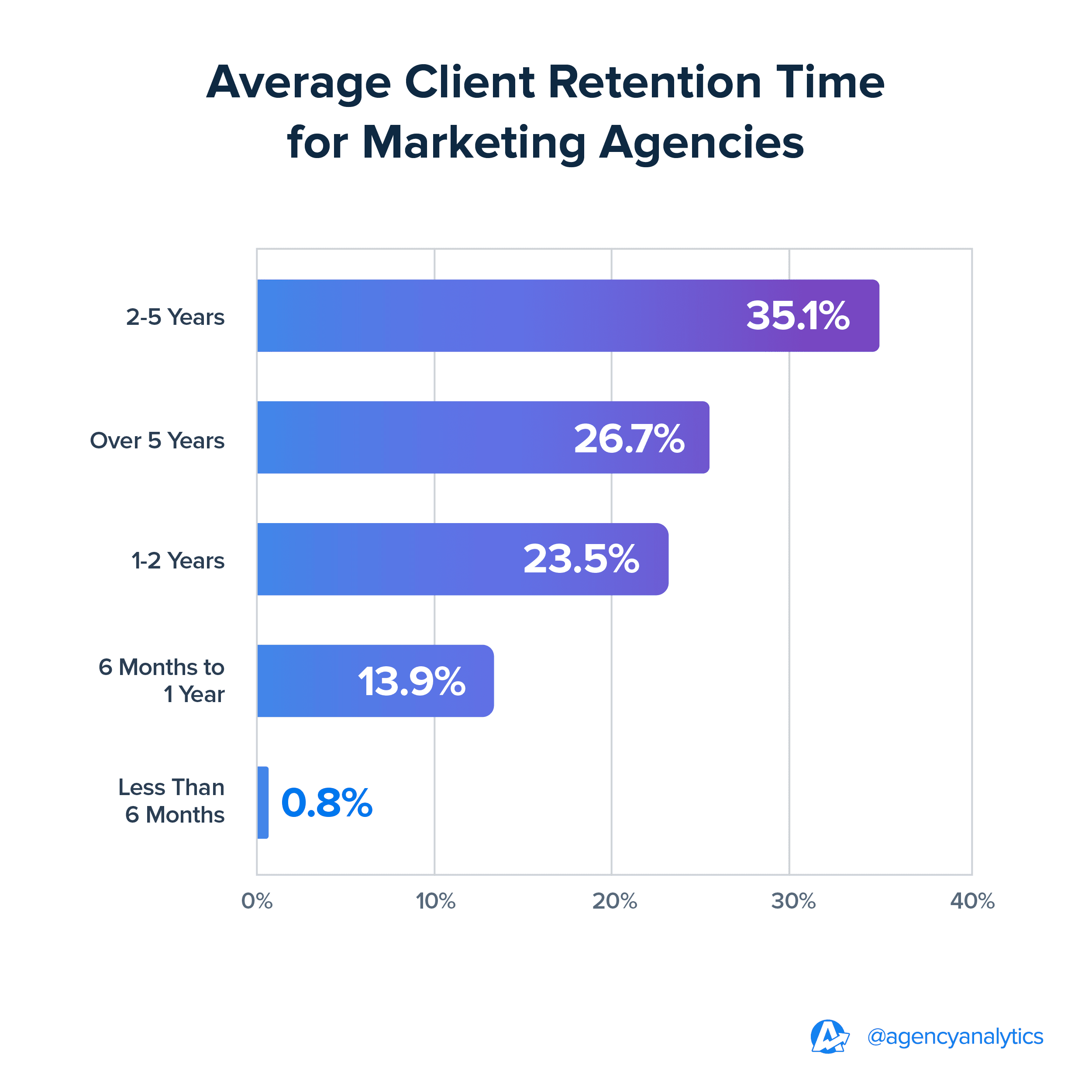
This indicates that clients aren’t always looking for a quick fix–many are interested in a long-term partnership with your agency.
Your agency’s retention rate is also valuable data. In many cases, it’s a gauge of overall satisfaction level, providing an opportunity to tighten internal processes and make improvements.
Retention is the ultimate sign of client happiness. Therefore, it is a lag indicator of your culture, systems, overall operations, and ability to generate results.
Tom Parker, Director, Dilate Digital
It’s also worth noting that clear communication and transparency were the top strategies for retaining clients. Which makes sense–after clients have invested in your agency, naturally, they want to see ROI. One of the best ways to show that is through consistently touching base and sharing results.
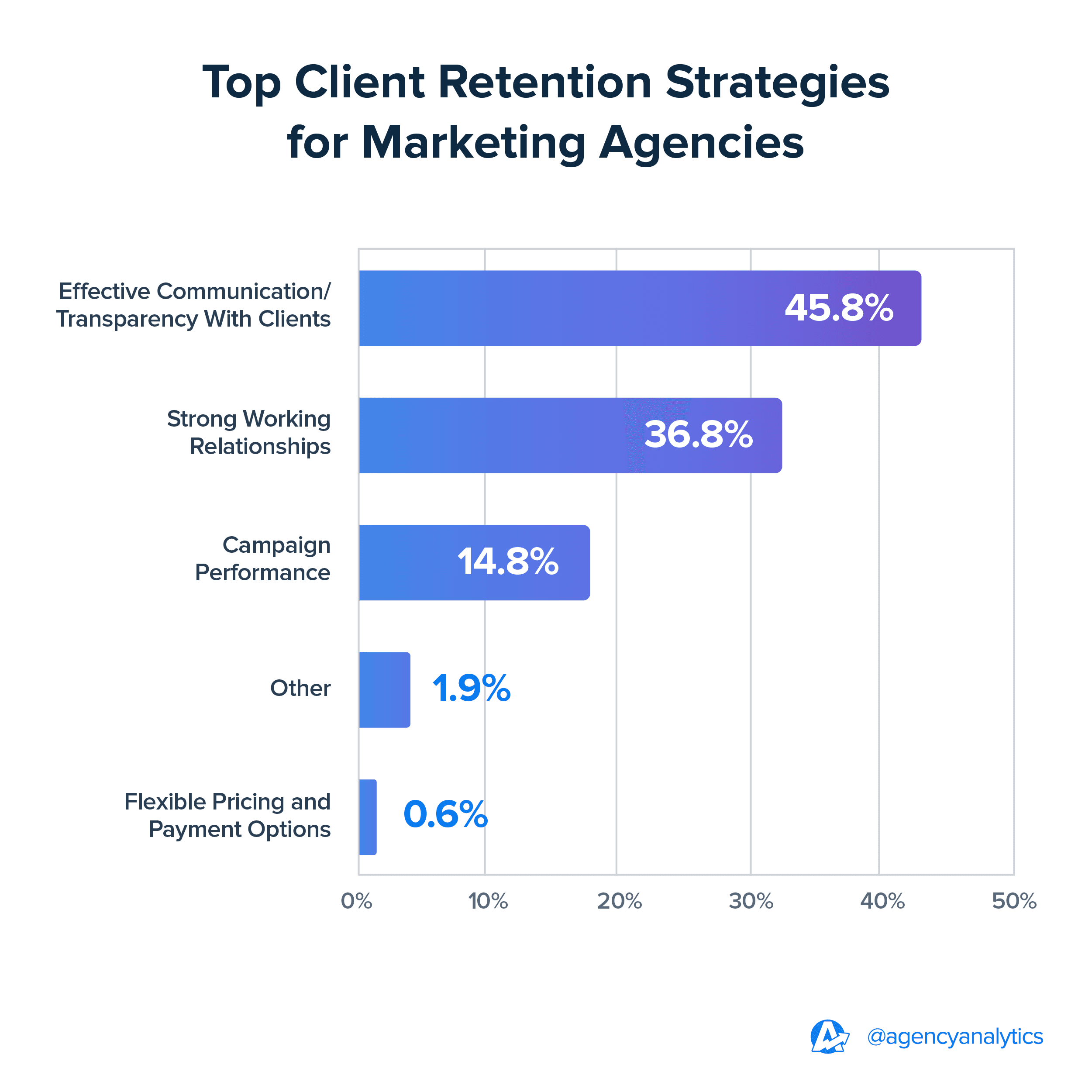
As 47% of agency leaders expressed, client reporting is absolutely critical for solid retention. It’s a way to show campaign progress, data trends, and recommendations for future strategies.
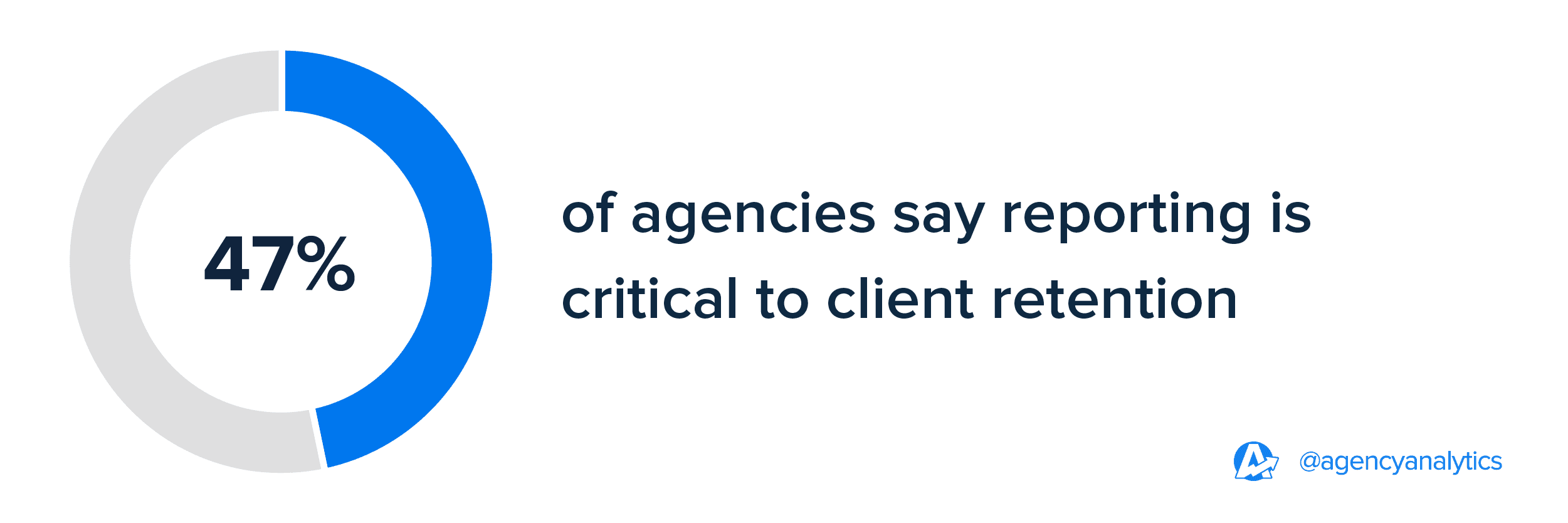
To sum things up, improve client retention by:
Focusing on Personalized Communication: Encourage Account Managers (or other liaisons) to touch base with clients regularly. This could include scheduled check-ins, personalized emails, or phone calls. Also, authenticity goes a long way. Build a rapport and show clients you genuinely care about their success.
Being Honest About Results: Be open about any strategic decisions made on behalf of your client. Even if they don’t yield the expected results, report on goal progress and any remedial steps your agency is taking.
Implementing a System for Identifying Issues Before They Become Major Problems: For example, use real-time dashboards to identify any campaign hiccups quickly.
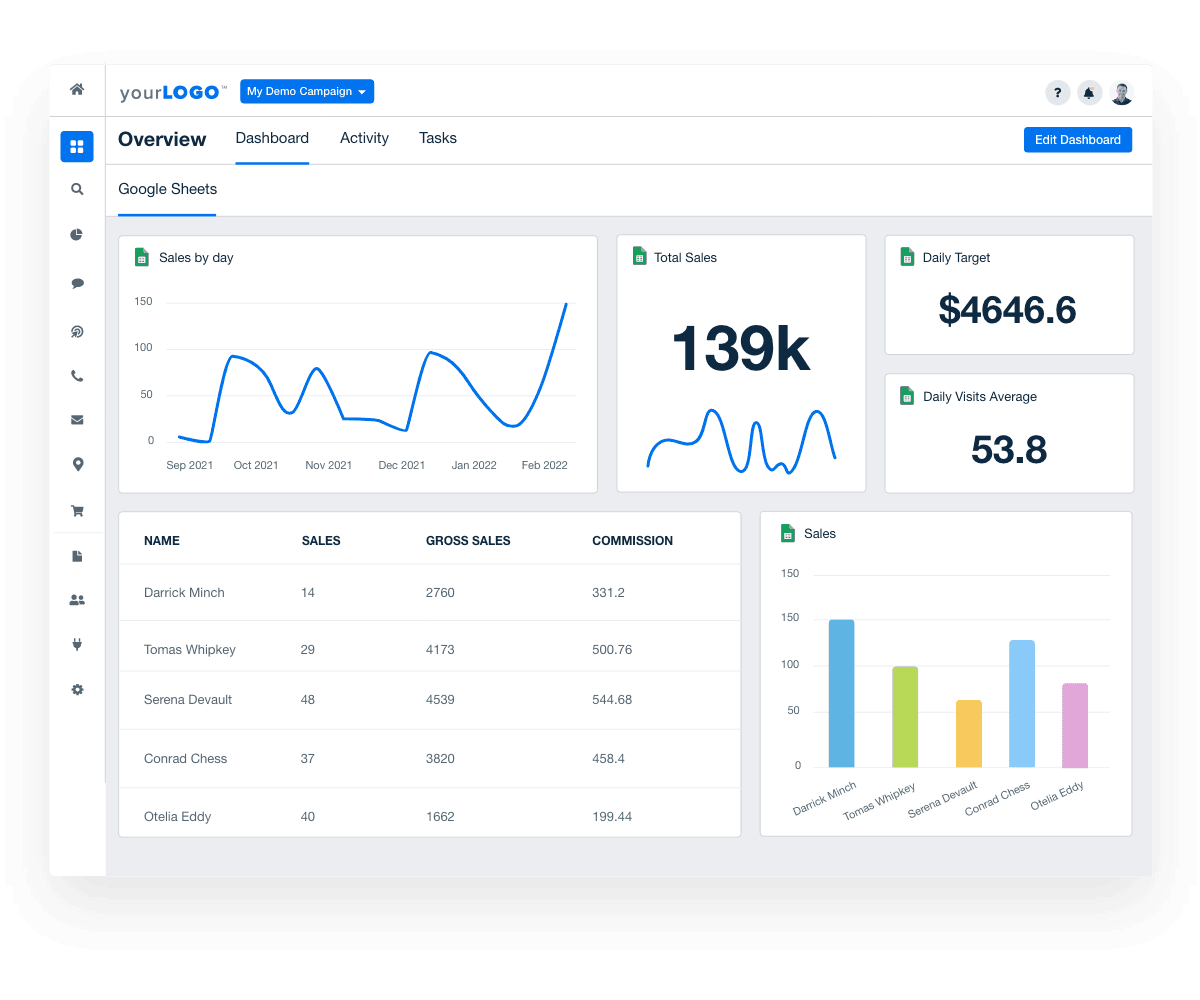
Invest in a system to monitor real-time metrics and make course corrections when necessary. Consolidate insights across 80+ marketing platforms–try AgencyAnalytics today, free for 14 days.
5. Project Management and Client Reporting Are the Keys to Agency Success
What’s the secret to sustainable business growth?
Well, there isn’t an exact formula. However, there’s one thing that 69% of agency leaders agree on: The importance of project and task management.
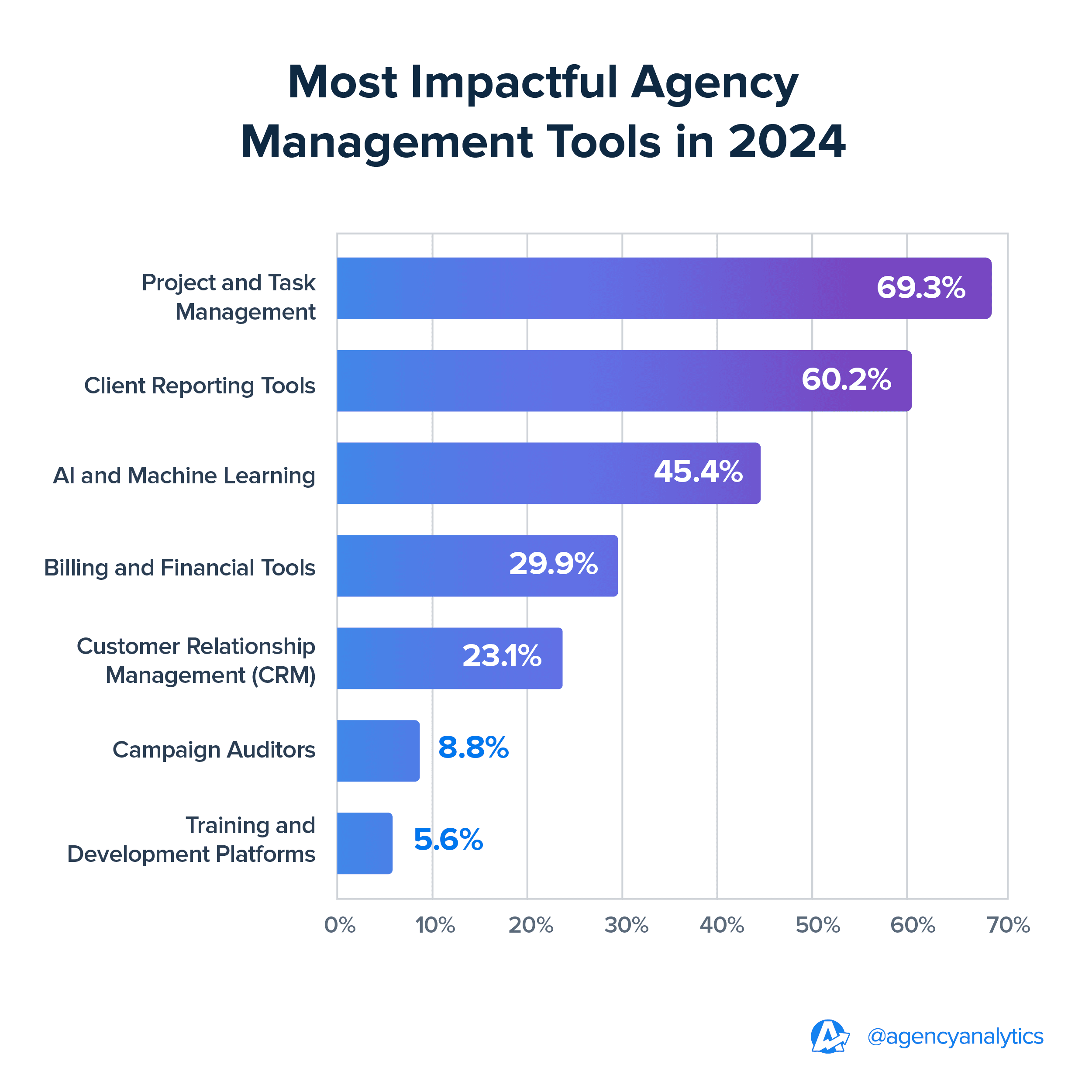
Think about it. As agencies grow, complexity increases.
Consider all the moving parts involved: An increase in client deliverables, timelines, team members, and even freelancers. At this stage, it becomes oh-so-easy to miss something (like a deadline or revision request).
That’s where a project management tool comes in. It’s a central system designed to streamline workflows, plan client projects, and ensure team accountability. To put it simply, it’s a must-have for all growing agencies.
Without effective project management, it’s easy to miss important pieces, and the team starts to cut corners. It helps us deliver projects on time, within budget, and to our clients’ required quality standards. It’s essential for competitiveness and long-term success.
Alejandra Villarreal, COO, Website Depot
It’s worth noting that nearly the same percentage of agency leaders (60%) emphasize the importance of client reporting tools.
Investing in the right system–like AgencyAnalytics–maximizes your billable time, removes the hassle of tedious data collection, and improves operational efficiency.
In fact, most agencies spend only 15 to 30 minutes creating a client report in AgencyAnalytics. This frees up more time for high-level activities like executing deliverables and creating strategies.
After switching to AgencyAnalytics, our agency has been able to reinvest that time in several ways. For example, our team can now dedicate extra attention to developing comprehensive marketing strategies tailored to each client's specific goals. We conduct in-depth research, analyze competitors, and explore innovative tactics to ensure highly effective client campaigns.
Jessica Crist, Production Manager, High Five Media
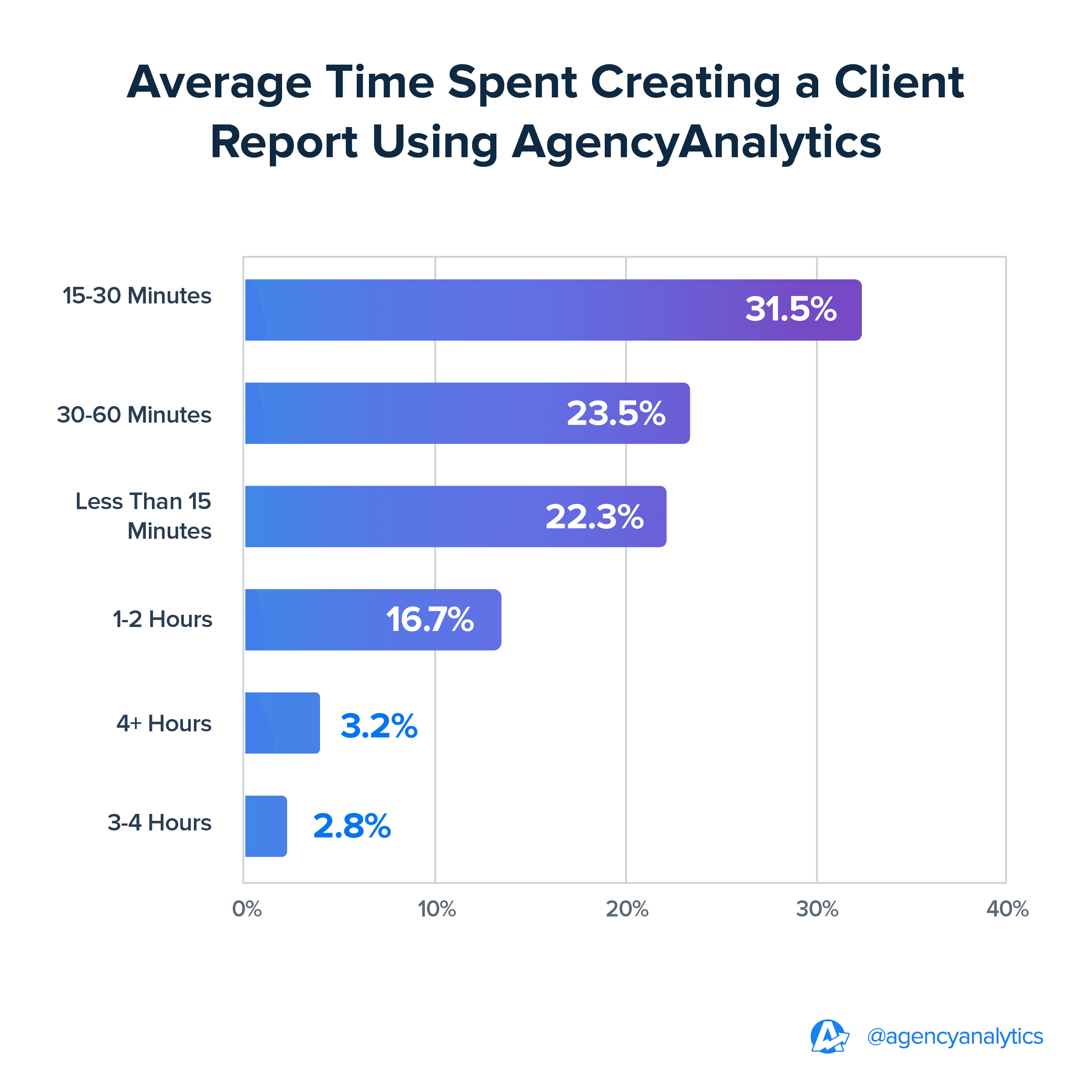
With AgencyAnalytics, there are a few key options like:
Using Pre-Built Reporting Templates: This is a popular way to save time and avoid creating a document from scratch.
Converting a Dashboard Into a Downloadable PDF: It’s also easy to generate a shareable link or send those insights as an email (whatever your client prefers).
Creating an 11-Second Smart Report That Auto-Populates With Your Client’s Unique Metrics: It’s the fastest option to generate a professionally designed and fully customizable report–all in a few clicks!

6. Monthly Reporting Is the Preferred Frequency for a Second Consecutive Year
Most agencies share results with clients monthly, which mirrors last year’s findings.
A monthly reporting cadence provides a consistent touch-point with the client while reducing hours spent analyzing and giving feedback on the data in reports. This allows for the majority of client billable time to be spent doing the work rather than reporting on it.
Lorianna Sprague, Vice President of Marketing, Trusted Search Marketing

Monthly reporting has several advantages. For starters, this frequency:
Gives Campaigns Enough Time To Materialize: Shorter reporting periods might not provide an accurate picture of campaign performance, especially those that require time to ramp up (e.g., SEO efforts).
Makes It Easier to Identify Trends: With a month’s worth of data, there’s more information to analyze. In turn, this empowers your agency to make more reliable, reasonable conclusions.
Creates a Feedback Loop: Monthly reports provide an opportunity for clients to ask for clarification and share follow-up questions. Overall, this ongoing dialogue helps strengthen the client-agency relationship.
While monthly reporting is a popular option, it will vary per campaign and client.
For example, short-term campaigns (e.g., a 2-week promotion for a retail client) may require more touchpoints or ad-hoc reports. On the other hand, some clients may want to be looped in before the end of the month.
Whatever the case, check in with your client and decide on the most appropriate reporting frequency and the level of data they need to see.
Ask your clients what data they want to see. Talk the client through the report as the more you talk to them the more you get to know them and identify other opportunities.
Paul Morris, Managing Director, Superb Digital
7. Most Agencies Do Not Charge Separately for Client Reports
After customizing a report, you might question whether an extra fee is justifiable.
To clear the air, consider that 53% of agencies include reporting costs in their overall fee. This way, they bill for their time while presenting clients with a single, upfront payment.
Plus, including client reporting in your regular agency fee signals that it's an essential part of your service, not just an afterthought.
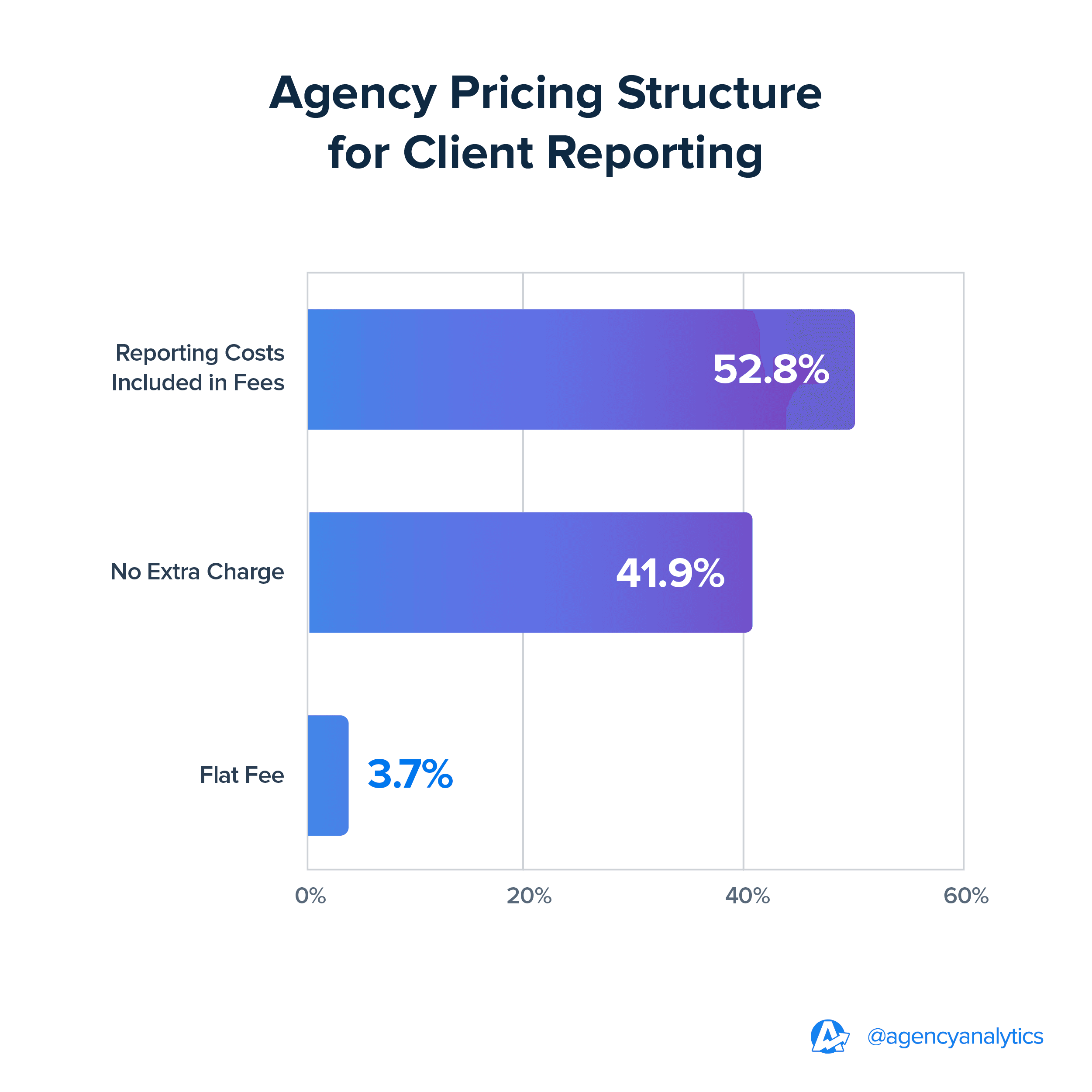
There may be some instances where reporting is more resource-intensive, though. For example, consider a large-scale programmatic advertising campaign. Because it involves multiple agency teams (e.g., Media Buying and Social Media), creating a cohesive report will require more internal coordination and approvals.
In cases like this, include a higher reporting cost within your agency’s final fee. That way, you’ll ensure all billable time is accounted for.
8. Most Clients Are Diligent About Reviewing Their Reports
After you’ve clicked the Send button, it’s normal to wonder, “Has my client actually read the report?”
According to 37% of agency leaders, the answer is yes… most of the time.

30% of agency leaders also noted that clients read their reports half the time.
With that said, you may wonder if it’s still necessary to send a report. Remember–it’s in your agency’s best interest to remain transparent. Even if clients don’t immediately read their report, it’s at their fingertips whenever they’re ready to review it.
Here’s another thing to consider: Most clients prefer a static report format and regularly scheduled meetings.
Therefore, don’t be too alarmed if a client hasn’t read their report. Perhaps they’re waiting to learn about their report findings via an in-person conversation (or video call).
Either way, a combination of the two seems to be the best solution.
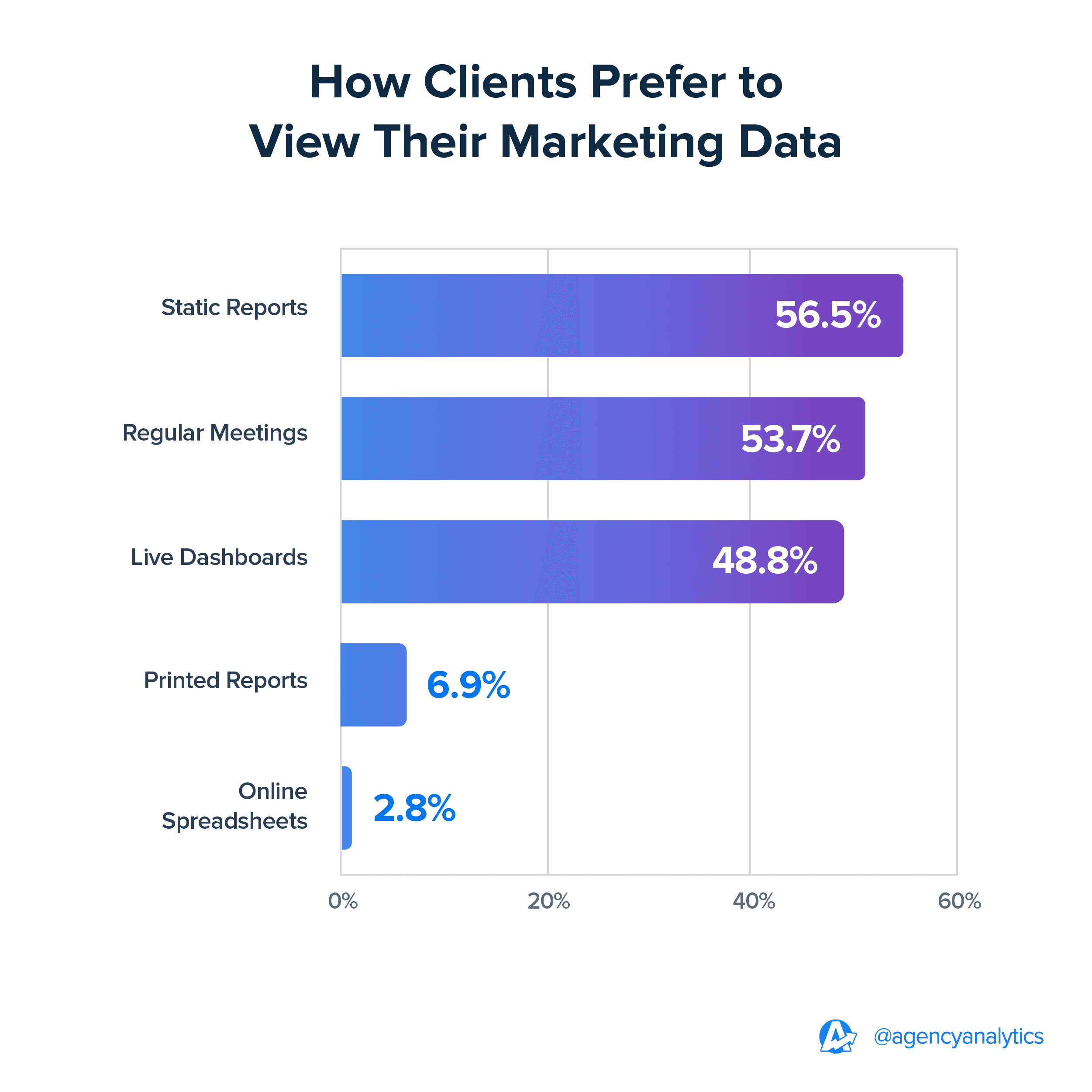
A significant percentage of clients (49%) also like having live dashboard access.
Essentially, it gives them autonomy and the ability to monitor campaign progress whenever they choose. In turn, it saves time from follow-up emails or calls, which is a win-win for both parties.
To avoid overwhelming clients with excessive data points (or vanity metrics), explore the user permissions feature. That way, you’ll have granular control over what’s shared.
9. Clients and Agencies Alike Value Data Visualization
Here’s another tip: Include data visualizations in all client reports.
Create reports that are clear, concise, and actionable. This means using data visualizations like charts, graphs, and tables. It will help clients quickly and easily understand the performance of their campaigns.
Daniel Dye, President, Native Rank
It transforms a heap of data into meaningful, easy-to-digest information. In fact, 75% of agency leaders confirmed that the clear visual representation of data is what clients like most about their reports.
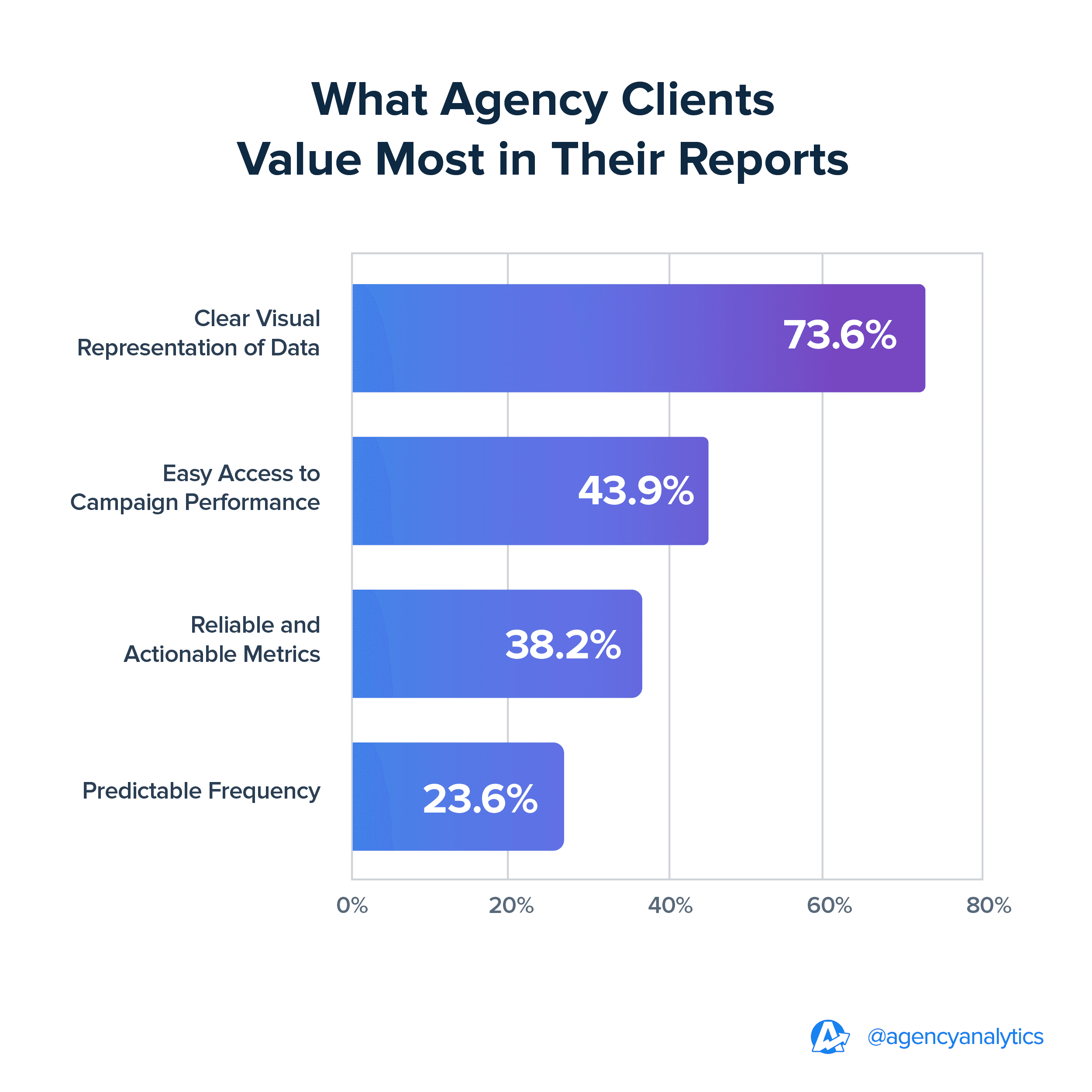
Similar to clients, agency leaders also see tremendous value in visuals. In fact, 41.1% have rated it as extremely important for client reporting.

It’s a shared sentiment all around: The ability to quickly gain visual insights at a glance is key to tracking client progress and communicating results.
10. Agencies Focus on High-Level Summaries and Key Data Sources
Let’s face it–clients are busy running their businesses. As we’ve seen, they may not always have time to explore reports in great detail.
That’s why it’s important to cut to the chase. Maximize your clients’ valuable time by including high-level overviews, which is what 41% of agencies do.
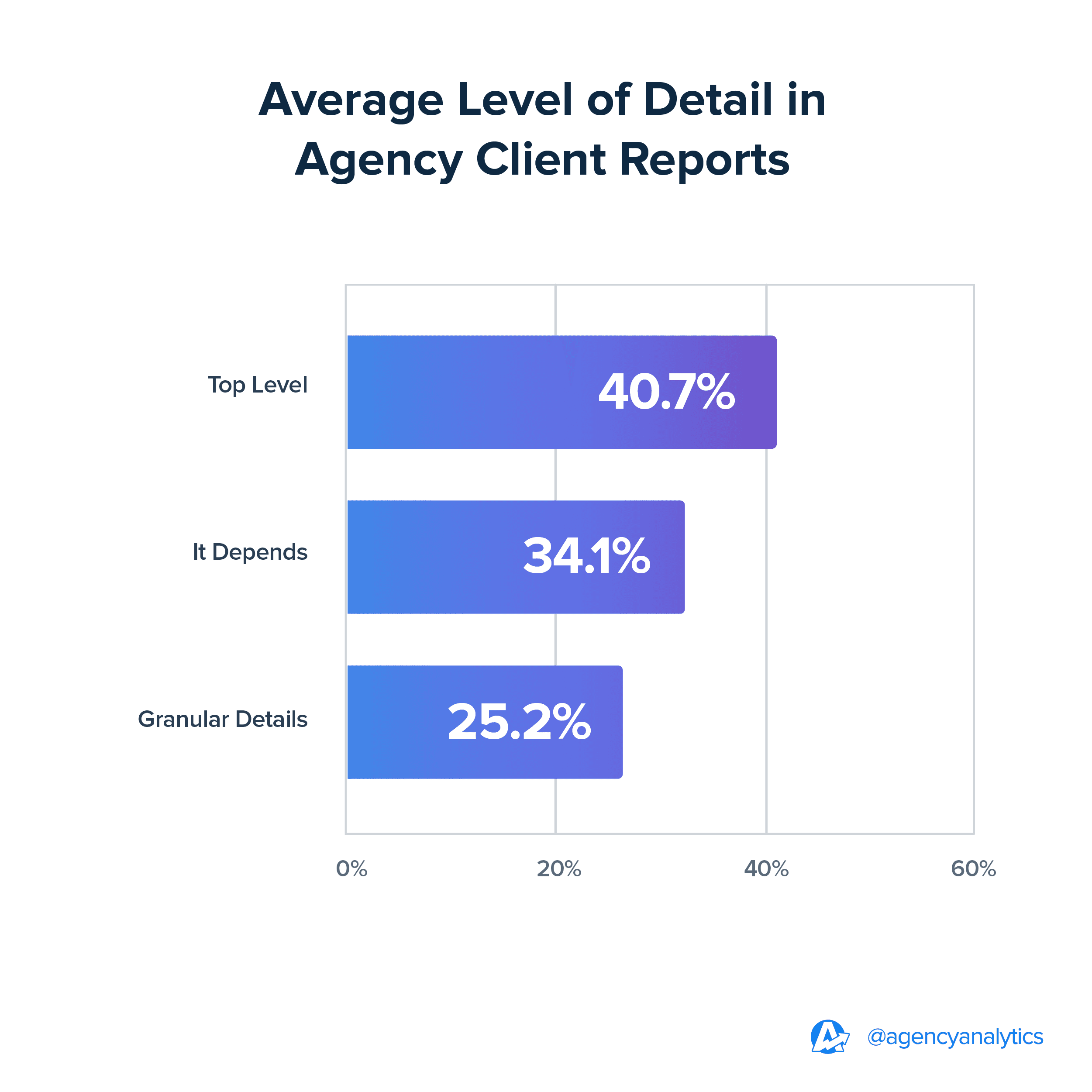
More specifically, consider including a custom executive summary at the start of each report. As a best practice, include a snapshot of campaign performance, quantitative insights, and recommendations for future strategies.
We like to create personalized report summaries for each client report. It’s helpful to have the majority of the report completed and simply update the summary at the end. Perfect balance!
Ariene, Digital Media Account Director, Connections Marketing
Similarly, most agencies (62%) choose to streamline the number of data sources included in reports to three to five per client.

By the time a custom cover page, summary, and metrics are included, it may range from eight to ten pages. While there’s no exact sweet spot, the idea is to convey critical data without being too overwhelming.
Not sure which metrics to focus on? Use the Smart Report feature in AgencyAnalytics to narrow your options.
Aside from auto-populating your client’s unique data, it’s also built around the top metrics shared by other agencies. This removes the guesswork, highlighting the insights that will likely matter to your client.
11. Clients Prioritize 1 to 5 KPIs, With Conversions Leading the Way
On a granular level, most clients are interested in 1 to 5 KPIs (as cited by 45% of agency leaders).

More specifically, 75% of clients are running conversion-driven campaigns. That means they’re likely most interested in metrics like online sales or app downloads (to name a few).
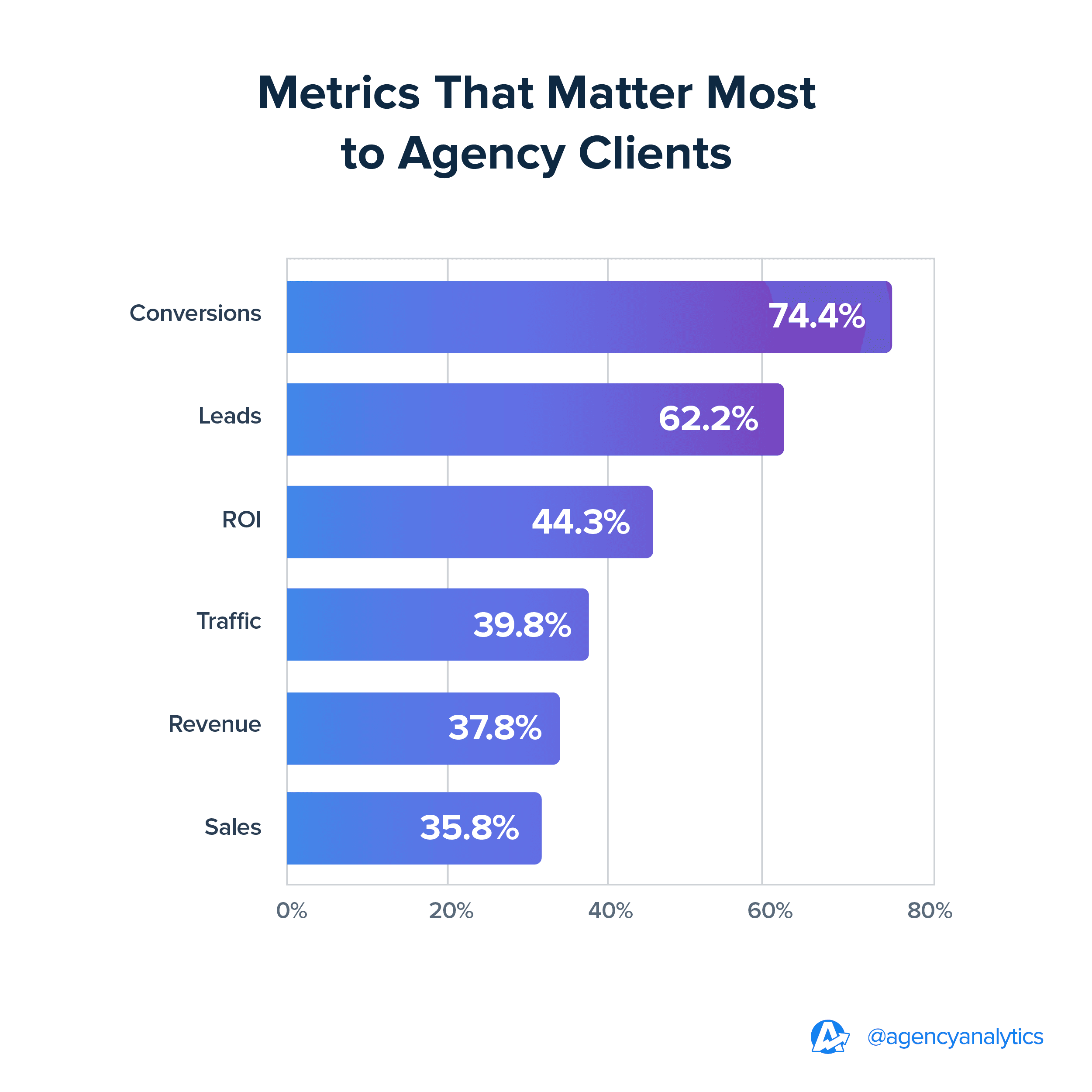
According to 62% of agencies, clients are also strongly interested in lead gen campaigns. In other words, there’s a focus on activities that result in revenue and profitability.
Going back to our earlier assertion, figure out what your client prioritizes. Then, use this to craft an effective report focusing on these data points.
12. Agencies Utilize Real-Time Internal Dashboards for Campaign Tracking
With so many campaigns and metrics, how are agencies keeping track of it all?
The answer is using live client dashboards for internal use. As 80% of agency leaders shared, it’s a way to monitor real-time insights, identify trends, and quickly rectify issues.
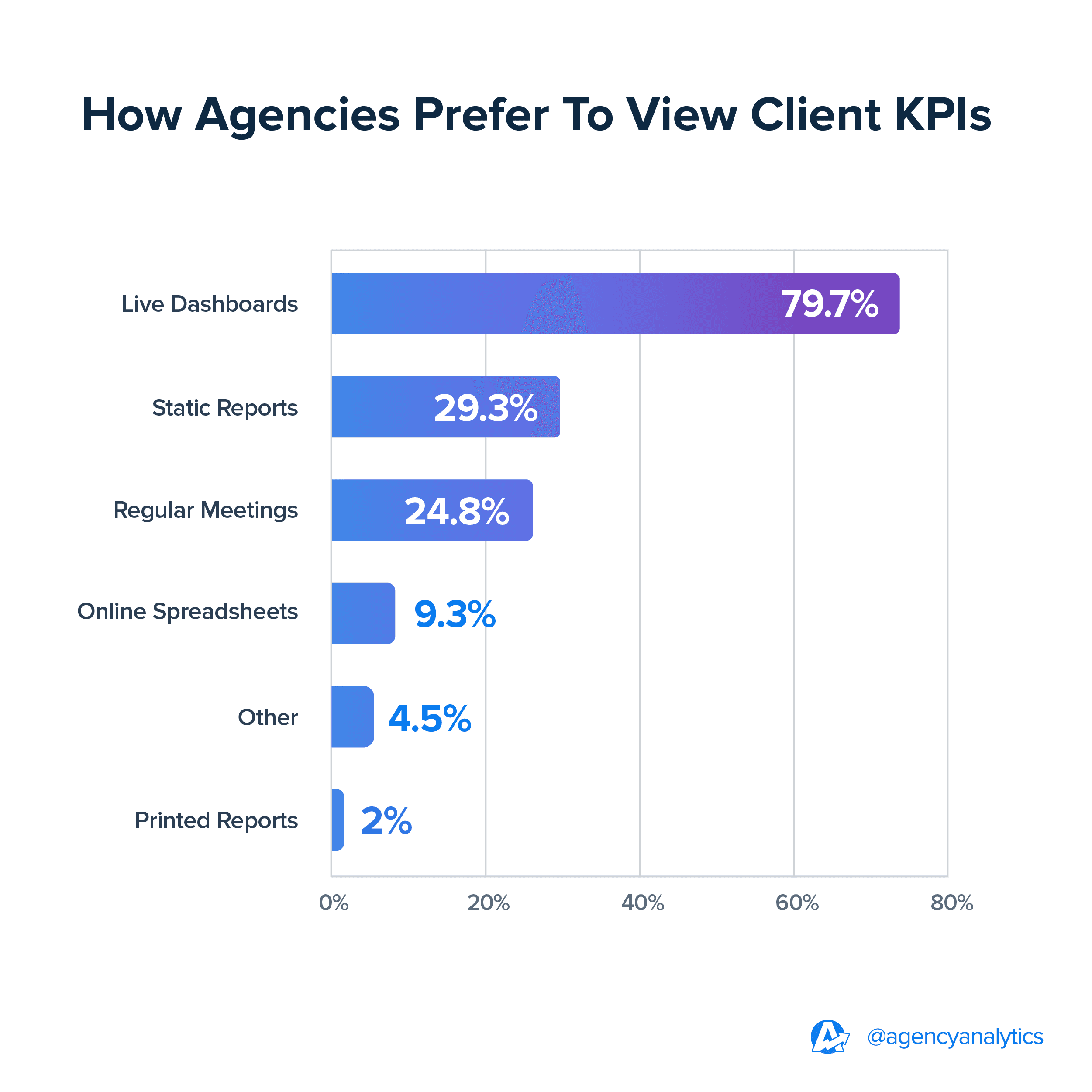
Need a bird’s eye view of all client campaigns? It’s simple–just create a multi-client dashboard. This way, you’ll be better equipped to identify campaign hiccups and monitor overall performance in a unified interface.
Invest in the Right Management Systems To Grow Your Agency
As we’ve covered, agencies have a lot going on.
In addition to the industry trends we’ve covered in part one, internal processes must be considered in the bigger scheme of things. To put it simply, robust agency management is non-negotiable (if you’re serious about growth, that is).
To summarize these findings, agencies should:
Prioritize Client Communication: Consider a blend of 1:1 meetings and regularly scheduled reports to ensure clients are well-informed.
Figure Out What Clients Value Most: Whether it’s conversions or engagement metrics, decide on clear OKRs or KPIs upfront.
Create Engaging, Relevant Reports: Maximize your clients’ time by using easy-to-digest data visualizations and high-level summaries. It’s a way to communicate the most important information off the bat.
Focus on Data Transparency: Use a client reporting tool like AgencyAnalytics to track campaigns in real-time, make course corrections, and show what was accomplished. Try it free for 14 days.
Use these agency management trends to tighten internal processes, implement new reporting habits, and plan for the year ahead. That way, you’ll be better positioned to take your agency to greater heights.
Interested in our most recent findings? Download the 2025 Marketing Agency Benchmarks Report today.

Written by
Faryal Khan is a multidisciplinary creative with 10+ years of experience in marketing and communications. Drawing on her background in statistics and psychology, she fuses storytelling with data to craft narratives that both inform and inspire.
Read more posts by Faryal KhanSee how 7,000+ marketing agencies help clients win
Free 14-day trial. No credit card required.






